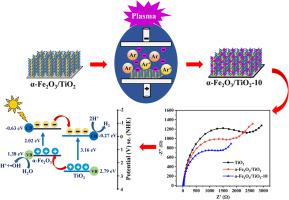Journal of Environmental Chemical Engineering ( IF 7.4 ) Pub Date : 2021-05-14 , DOI: 10.1016/j.jece.2021.105660 Weerapong Bootluck , Thawat Chittrakarn , Kuaanan Techato , Watsa Khongnakorn

|
In this work, hematite (α-Fe2O3) deposited on anatase TiO2 was modified by plasma treatment and studied. α-Fe2O3/TiO2 was successfully synthesized using sol-gel precipitation methods and the surface was modified by argon (Ar) gas plasma treatment to increase photocatalyst nanocomposite activity. The effect of Ar-plasma treatment times from 5 to 20 min at DC glow discharge powers of 50 watts was investigated. The crystal structures, surface morphology, optical properties were characterization by using X-ray Diffractometry (XRD), scanning electron microscopy (SEM), transmission electron microscopy (TEM), atomic force microscopy (AFM), UV-vis spectrometry (UV-Vis), X-ray photoelectron spectroscopy (XPS), photoluminescence spectroscopy (PL) and electrochemical impedance spectroscopy (EIS). After plasma treatment, the crystalline phase of TiO2 form changed from pure anatase to a mixture of anatase and rutile phases. The particle size was reduced from 25 to 20 nm. The band gap energy decreased from approximately 2.18 eV to 1.84 eV and exhibited a wider absorption edge under visible light irradiation (400-700 nm). Ar-plasma modification of the surface showed the attribution of oxygen vacancies and Ti3+. The plasma treatment improved the heterojunction photocatalyst to enhance the photocatalytic activity under visible light for H2 evolution. The best photocatalytic activity for H2 evolution rate was obtained at 1.25 mmol h-1 for α-Fe2O3/TiO2-10 photocatalyst compared to α-Fe2O3/TiO2-untreated (0.13 mmol h-1). The plasma treatment on photocatalyst materials showed long-term stability and excellent separation of the photogenerated charge carriers.
中文翻译:

表面的改性的α-Fe 2 ö 3 /二氧化钛2光催化剂的纳米复合材料与由Ar气等离子体处理氢演进的增强的光催化活性
在这项工作中,赤铁矿(α-的Fe 2 ö 3沉积在锐钛矿型的TiO)2是通过等离子体处理改性的和研究。的α-Fe 2 ö 3 /二氧化钛2是使用溶胶-凝胶沉淀方法成功地合成和表面用氩气改性(Ar)气等离子处理以提高光催化剂的纳米复合材料的活性。等离子体处理时间从5到20的效果 研究了直流辉光放电功率为50瓦时的最小电流。使用X射线衍射(XRD),扫描电子显微镜(SEM),透射电子显微镜(TEM),原子力显微镜(AFM),紫外可见光谱(UV-Vis)表征晶体结构,表面形态,光学性质),X射线光电子能谱(XPS),光致发光光谱(PL)和电化学阻抗谱(EIS)。在等离子体处理之后,TiO 2的晶相形式从纯锐钛矿变为锐钛矿和金红石相的混合物。粒径从 25nm降低至20nm。带隙能量从大约2.18 eV下降到1.84 eV,并且在可见光辐照下表现出更宽的吸收边(400-700) 纳米)。表面的等离子体改性显示氧空位和Ti 3+的归属。等离子体处理改进了异质结光催化剂,以增强可见光下H 2析出的光催化活性。对于H中的光催化活性最好2以1.25得到释放速率 毫摩尔 ħ -1为的α-Fe 2 ö 3 /二氧化钛2 -10的光催化剂相比的α-Fe 2 ö 3 /二氧化钛2 -untreated(0.13 毫摩尔 ħ -1)。对光催化剂材料进行的等离子体处理显示出长期稳定性,并且光生载流子的分离效果极好。











































 京公网安备 11010802027423号
京公网安备 11010802027423号